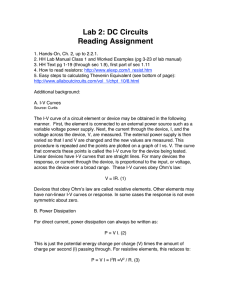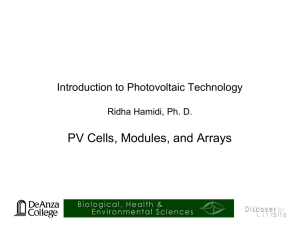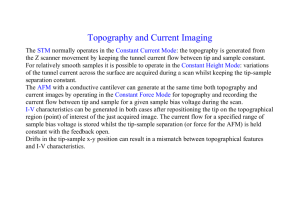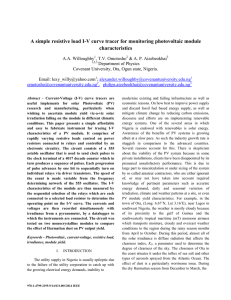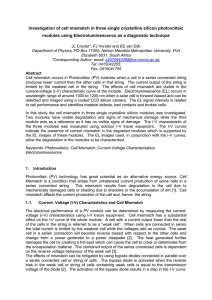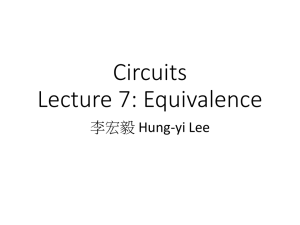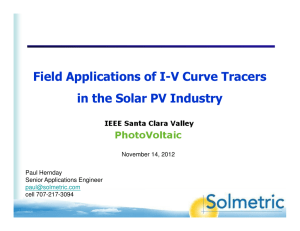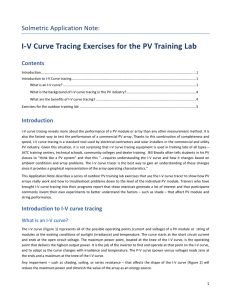File
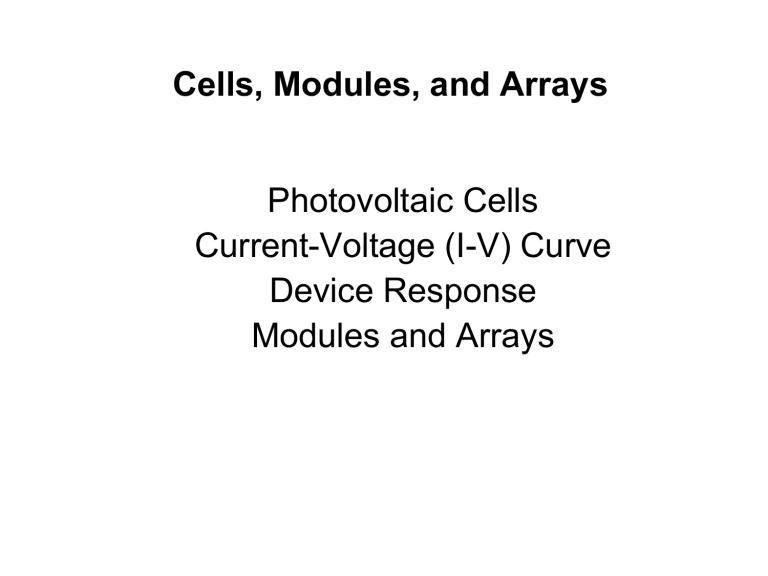
Cells, Modules, and Arrays
Photovoltaic Cells
Current-Voltage (I-V) Curve
Device Response
Modules and Arrays
Basic Building Blocks
The basic building blocks for PV systems include cells, modules, and arrays.
Semiconductors
Semiconductor materials with special electrical properties can be made by adding small amount of other elements to silicon crystals.
Photovoltaic Effect
The photovoltaic effect produces free electrons that must travel through conductors in order to recombine with electron voids, or “holes”.
PV Material Efficiencies
Various PV materials and technologies produce different efficiencies.
Monocrystalline Ingots
Monocrystalline silicon wafers are sawn from grown cylindrical ingots.
Electromagnetic Spectrum
Polycrystalline silicon wafers are sawn from cast rectangular ingots.
Cell Fabrication
Several steps are involved in turning silicon wafers into
PV cells.
Different PV Cells
The different materials, processes, and manufacturing steps produce a range of PV cell types.
An I-V curve illustrates the electrical output profile of a PV cell, module, or array.
I-V Curve
Open-Circuit Voltage
Open-circuit voltage is easily measured with a digital multimeter (DMM).
Short-Circuit Current
Using in-line and clamp-on ammeters are two methods of measuring shortcircuit current.
I-V Curve with Power
A power against voltage curve clearly shows the maximum power point.
Fill factor represents the shape of an I-V curve.
Fill Factor
Efficiency is a measure of how effectively a PV device converts solar power to electrical power.
Efficiency
Equivalent Circuit
A PV cell can be modeled by a current source in parallel with a diode, with resistance in series and in parallel.
Series Resistance
Increasing series resistance in a
PV system flattens the knee in the I-V curve, reducing maximum power, fill factor, and efficiency.
Shunt (Parallel) Resistance
Decreasing shunt resistance reduces fill factor and efficiency and lowers maximum voltage, current, and power, but it does not affect short-circuit current.
Solar Irradiance Response
Voltages increases rapidly up to about
200 W/m 2 , and then is almost constant.
Current increases with irradiance.
Temperature Response
Increasing cell temperature decreases voltage, slightly increases current, results in a net loss of power.
Module Construction
Modules are constructed from PV cells surrounded by several layers of protective materials.
Arrays of PV Modules
An array is a group of PV modules integrated as a single powergenerating unit.
Panel from Modules
Several modules may be connected together to form a panel, which is installed as a preassembled unit.
Junction Box
A junction box on the back of a module provides a protected location for electrical connections and diodes.
Series Connections of Cells and Modules
PV cells or modules are typically connected in series strings to build voltage.
I-V Curves of Series Strings
The overall I-V characteristics of a series strings are dependent on the similarity of the current outputs of the individual devices.
Parallel Connections
Strings of PV cells or modules may be connected in parallel to build current.
Building an Array
Modules are added in series to form strings or panels, which are then combined in parallel to form arrays.
I-V Curve for PV Devices in Parallel
The overall I-V characteristics of a system of PV devices in parallel are dependent on the similarity of the current outputs of the individual devices.
Bypass Diode
Bypass diodes allow current to flow around devices that develop an open circuit or high-resistance condition.
Breakdown Voltage
A bypass diode prevents a large breakdown voltage from allowing a
PV device to dissipate a large amount of power.
Module Nameplates
Module nameplates must include performance ratings for the module and may include other information used to design a PV system.
Test Conditions
Various test conditions can be used to evaluate module performance and may produce different results.
